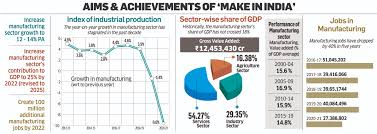MAKE
IN INDIA Vs MAKE FOR
INDIA
In Sep 2014 Modiji
launched the Make in India
initiative which is very good for our country's economic growth. Make in India means manufacturing of goods and
services in India and exporting them to the worldwide market. Due to
this, there is an increase in our GDP
growth which is very important for knowing the economy of one country. This
initiative provides employment to many people. Indian startups have grown due
to the Make in India initiative.
Made in India- means
the product is manufactured in our country which makes our country self-reliant. Make in India mission
will increase GDP and provide more
employment. As unemployment is a major problem due to the high population
we should go for the Make in India mission. By Make in India we can export
goods to other countries and limit import which helps to make our country more
powerful and high economy. It is a major national
programme of the government of India designed to facilitate investment, foster innovation, enhance skill development, protect intellectual
property and build the best manufacturing infrastructure in the country.
"Make for India' involves production for consumption in India itself. Given
that India is one of the largest consumer markets especially in consumer
durables and electronics, the concept of "Make for India' could be a game changer.
It gives our growth an independence from the international economic dependence and also helps enhance the
poverty levels in the country. It furthers the idea of constructing a
synergetic production-consumption cycle in India itself. The primary objective
of this initiative is to attract investments from across the globe and
strengthen India's manufacturing sector for export. However, this ambitious
plan was criticized by economists,
one of whom was former RBI governor Raghuram Rajan. In a famous speech he
warned against the possible liabilities and exposures in pursuing an export-led growth model. "Make in
India' pushes the standpoint of an export-oriented growth. Leveraging India's inexpensive labour and other resources to keep costs low. It will boost exports
to improve the domestic production base.
"Make For India' would be the shot in the arm the manufacturing sector needs. It will craete the ground swell which will "Make in India' succeed. By manufacturing essential technologies in India, the dependence on foreign players and companies would decrease, products and services will become cheaper in India. Indian companies will lead the manufacturing positions and portfolios for companies around the world. What is made for India, manufacturing of goods and services in India are sold in the Indian market only. They are not exported to another country hence it's not much beneficial for country's economic growth. It only provides employment and makes us 'Aatmanirbhar'. Research and development with the use all the young, brilliant minds increase. It would also generate millions of jobs, both skilled and labour intensive, and would increase India's economic stature and overall self-reliance.
Made
for India means the products made in our country. It is silent
about enhancement of export. Made for
India is not much helpful because it will neither provide much employment nor
increase GDP.
A good example of this
might be seen in the consumer durables
market itself. India is a huge consumer of electronic gadgets and products such as mobile phones, televisions, laptops and several other homes appliances white good. Almost all
of this money is being pocketed by the international companies who manufacture the
components of these products and send them to India, where they are only
assembled. If the components were to be manufactured in India, this money would not only stay within the country, it will increase
the south-east Asian markets as well.
Components and tools manufactured for India would mean they need to be stress tested for Indian conditions, which includes a wide range of use cases and environmental changes. India is a vast country with topical climate, desert heat as well as icy cold mountainous regions. Components and products manufactured for Indian conditions would automatically imply they would be applicable for a large number of countries around the world. This would further increase the capability of the manufacturing sector and produce globally recognised Indian manufacturing companies.
The
Road Block: This kind of hybrid,
holistic model will require a quintessential pre-requisite in the form of domestic legal/financial as well as industrial
reforms. It will also require
amendments in ease of manufacturing. The monitoring and governing
organizations for businesses in India, is still not expansion and innovation
friendly, neither for Make in India nor Make for India. The reforms needed to
smoothen the processes for both these models will be the key contributing
factor to India becoming a global
industrial power.
I still like to say
that making in India is better than making for India. India is a developing
country, it requires more employment.
Hence more manufacturing units at the different parts of the country are
required. The main purpose of this concept is to provide employment to people
who are not much educated and not that
skilled. It will create a lot of jobs in the next few years and will also
help India not to rely on other countries. Our country will be self-dependent.
Economies do not grow
linearly based on just a singular, specific model, however hard we try. India
needs to create a hybrid, symbiotic
model, starting with Make for India, which gratifies the domestic
developmental shortfall, while offering significant space for global economic
atmosphere. If India truly wants to achieve its $5 trillion economy goal,
it needs to start making its own brands of popular electronic goods categories,
that go on to make a mark in global markets. Our evolving industrial revolution
essentially requires a strong blend of Make for India and Make in India.







No comments:
Post a Comment
Thanks for your views. We will work on it. Meanwhile, do visit this blog for an interesting Article tomorrow. Have a nice day.